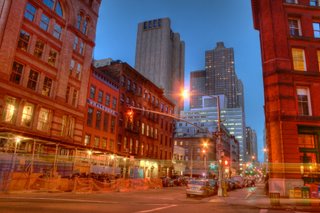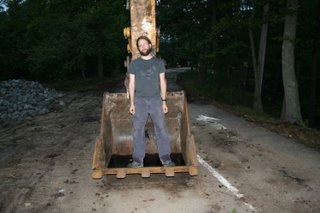Monday, December 18
What Should a Billionaire Give – and What Should You? By PETER SINGER
What is a human life worth? You may not want to put a price tag on a
it. But if we really had to, most of us would agree that the value of
a human life would be in the millions. Consistent with the foundations
of our democracy and our frequently professed belief in the inherent
dignity of human beings, we would also agree that all humans are
created equal, at least to the extent of denying that differences of
sex, ethnicity, nationality and place of residence change the value of
a human life.
.....
Obviously, the rich in other nations should share the burden of
relieving global poverty. The U.S. is responsible for 36 percent of
the gross domestic product of all Organization for Economic
Cooperation and Development nations. Arguably, because the U.S. is
richer than all other major nations, and its wealth is more unevenly
distributed than wealth in almost any other industrialized country,
the rich in the U.S. should contribute more than 36 percent of total
global donations. So somewhat more than 36 percent of all aid to
relieve global poverty should come from the U.S. For simplicity, let's
take half as a fair share for the U.S. On that basis, extending the
scheme I have suggested worldwide would provide $808 billion annually
for development aid. That's more than six times what the task force
chaired by Sachs estimated would be required for 2006 in order to be
on track to meet the Millennium Development Goals, and more than 16
times the shortfall between that sum and existing official development
aid commitments.
If we are obliged to do no more than our fair share of eliminating
global poverty, the burden will not be great. But is that really all
we ought to do? Since we all agree that fairness is a good thing, and
none of us like doing more because others don't pull their weight, the
fair-share view is attractive. In the end, however, I think we should
reject it. Let's return to the drowning child in the shallow pond.
Imagine it is not 1 small child who has fallen in, but 50 children. We
are among 50 adults, unrelated to the children, picnicking on the lawn
around the pond. We can easily wade into the pond and rescue the
children, and the fact that we would find it cold and unpleasant
sloshing around in the knee-deep muddy water is no justification for
failing to do so. The "fair share" theorists would say that if we each
rescue one child, all the children will be saved, and so none of us
have an obligation to save more than one. But what if half the
picnickers prefer staying clean and dry to rescuing any children at
all? Is it acceptable if the rest of us stop after we have rescued
just one child, knowing that we have done our fair share, but that
half the children will drown? We might justifiably be furious with
those who are not doing their fair share, but our anger with them is
not a reason for letting the children die. In terms of praise and
blame, we are clearly right to condemn, in the strongest terms, those
who do nothing. In contrast, we may withhold such condemnation from
those who stop when they have done their fair share. Even so, they
have let children drown when they could easily have saved them, and
that is wrong.
Similarly, in the real world, it should be seen as a serious moral
failure when those with ample income do not do their fair share toward
relieving global poverty. It isn't so easy, however, to decide on the
proper approach to take to those who limit their contribution to their
fair share when they could easily do more and when, because others are
not playing their part, a further donation would assist many in
desperate need. In the privacy of our own judgment, we should believe
that it is wrong not to do more. But whether we should actually
criticize people who are doing their fair share, but no more than
that, depends on the psychological impact that such criticism will
have on them, and on others. This in turn may depend on social
practices. If the majority are doing little or nothing, setting a
standard higher than the fair-share level may seem so demanding that
it discourages people who are willing to make an equitable
contribution from doing even that. So it may be best to refrain from
criticizing those who achieve the fair-share level. In moving our
society's standards forward, we may have to progress one step at a
time.
For more than 30 years, I've been reading, writing and teaching about
the ethical issue posed by the juxtaposition, on our planet, of great
abundance and life-threatening poverty. Yet it was not until, in
preparing this article, I calculated how much America's Top 10 percent
of income earners actually make that I fully understood how easy it
would be for the world's rich to eliminate, or virtually eliminate,
global poverty. (It has actually become much easier over the last 30
years, as the rich have grown significantly richer.) I found the
result astonishing. I double-checked the figures and asked a research
assistant to check them as well. But they were right. Measured against
our capacity, the Millennium Development Goals are indecently,
shockingly modest. If we fail to achieve them — as on present
indications we well might — we have no excuses. The target we should
be setting for ourselves is not halving the proportion of people
living in extreme poverty, and without enough to eat, but ensuring
that no one, or virtually no one, needs to live in such degrading
conditions. That is a worthy goal, and it is well within our reach.
Peter Singer is the Ira W. DeCamp professor of bioethics at the Center
for Human Values at Princeton University. He is the author of many
books, including most recently "The Way We Eat: Why Our Food Choices
Matter."
Wednesday, November 29
ATM fees at Bank of America savings accounts
BOA is great in New York City, since their ATM's are ubiquitous. What BOA did in the past year is very deceptive. If you use another banks ATM, you are charged a fee (usually by the other bank, and by BOA). Savings account users at BOA can now use their ATM only three times (or make three counter transactions) eah month. Use an ATM four times, and BOA starts charging you. Pretty soon, you are spending $9 a month to use your ATM six times. Take a look at the fees for yourself.
Your interest rate for a savings account is 0.2%. A $3,000 account will earn $6 a year (correct me if I'm wrong). In the meantime, you've spent $108 in ATM/counter fees (assuming you visit the bank 6 times a month).
Your best bet is to open a checking account, which gives you another lousy interest rate, but at least BOA doesn't penalize you for using an ATM.
Wednesday, November 1
Kiva.org Celebrates First Year of Online Microfinance
First Web Site to Let Anyone With a PayPal Account Be a "Banker to the Poor" Marks First Year With Unprecedented Success
SAN FRANCISCO, CA -- (MARKET WIRE) -- October 17, 2006 -- Kiva.org, the first person-to-person micro-lending Web site that enables an individual to finance a micro-entrepreneur in the developing world, marked its first year anniversary. Since its launch, Kiva.org has become known as "the merger between Microfinance and Web 2.0" due to its ability to create a transparent, connective and affordable option for anyone on the Internet to lend directly to the working poor. Inspired by Mohammad Yunus and Grameen Bank, Kiva's aspiration was to take microfinance online; in just one year, the organization has been widely recognized as the leader in online microfinance, has attracted a significant base of lenders, borrowers and partners, has built a staff and board of directors, and has received accolades from the press and industry leaders.
Kiva - microcredit from your computer to Africa
Kiva, which means "agreement" or "unity" in Swahili, would allow people with a little bit of extra cash to use their credit card or the online money transfer company, PayPal, to lend directly to African entrepreneurs. Kiva got its start a little more than a year ago in Uganda, where it forged partnerships with local microfinance institutes so that each business would be vetted and approved before being posted on the site.
Saturday, September 30
The view from WTC7
Tuesday, September 12
High dynamic range imaging is the new black
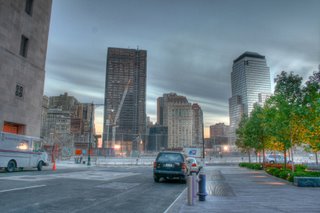
WTC, Deutche Bank, WTC Post office


West Broadway

The tip of Tribeca

Tribeca

7 World Trade Center, West Broadway and Warren

West Broadway

Jersey City Sunset

West Broadway, Chambers
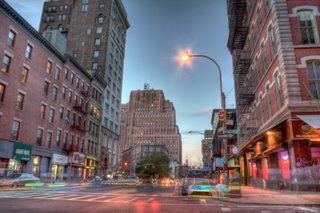

West Broadway, Chambers
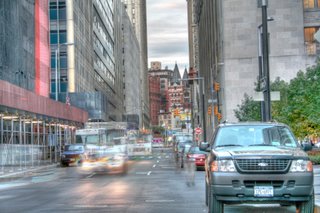

Jeff Koons Balloon Sculpture in front of 7 WTC
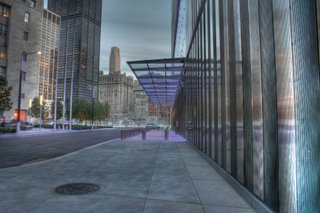
The entrance to 7 WTC

Koon's ballon scuplture in front (behind) the post office

Looking up at 7 WTC


The end of Greenwich St.

The west side and the Holland Tunnel, with water from the carribean.

Jersey City as Miami

Battery Park City, 7 World Trade Center
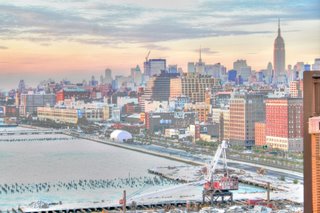
Hudson River Esplanade, West Side Highway

Jersey City/Hudson River Sunset
High dynamic range imaging
From Wikipedia, the free encyclopedia
In computer graphics and cinematography, high dynamic range imaging (HDRI) is a set of techniques that allow a far greater dynamic range of exposures than normal digital imaging techniques. The intention of HDRI is to accurately represent the wide range of intensity levels found in real scenes ranging from direct sunlight to the deepest shadows.
HDRI was originally developed for use with purely computer-generated images. Later, methods were developed to produce a HDR image from a set of photos taken with a range of exposures. With the rising popularity of digital cameras and easy to use desktop software, many amateur photographers have used HDRI methods to create photos of scenes with a high dynamic range (i.e a large difference between light and dark areas). However, HDRI has many other applications and "HDRI" should not be mistaken for just this use.
When preparing for display, a high dynamic range image is often tone mapped and combined with several full screen effects.
Monday, September 11
More High dynamic range imaging

Rockafeller Park, Battery Park City

Jersey City from Battery Park City

The battery park city neighborhood
High dynamic range imaging
In computer graphics and cinematography, high dynamic range imaging (HDRI) is a set of techniques that allow a far greater dynamic range of exposures than normal digital imaging techniques. The intention of HDRI is to accurately represent the wide range of intensity levels found in real scenes ranging from direct sunlight to the deepest shadows.HDRI was originally developed for use with purely computer-generated images. Later, methods were developed to produce a HDR image from a set of photos taken with a range of exposures. With the rising popularity of digital cameras and easy to use desktop software, many amateur photographers have used HDRI methods to create photos of scenes with a high dynamic range (i.e a large difference between light and dark areas). However, HDRI has many other applications and "HDRI" should not be mistaken for just this use.
When preparing for display, a high dynamic range image is often tone mapped and combined with several full screen effectsTuesday, September 5
High dynamic range imaging



High dynamic range imaging
In computer graphics and cinematography, high dynamic range imaging (HDRI) is a set of techniques that allow a far greater dynamic range of exposures than normal digital imaging techniques. The intention of HDRI is to accurately represent the wide range of intensity levels found in real scenes ranging from direct sunlight to the deepest shadows.
HDRI was originally developed for use with purely computer-generated images. Later, methods were developed to produce a HDR image from a set of photos taken with a range of exposures. With the rising popularity of digital cameras and easy to use desktop software, many amateur photographers have used HDRI methods to create photos of scenes with a high dynamic range (i.e a large difference between light and dark areas). However, HDRI has many other applications and "HDRI" should not be mistaken for just this use.
When preparing for display, a high dynamic range image is often tone mapped and combined with several full screen effects.
ontrast.












